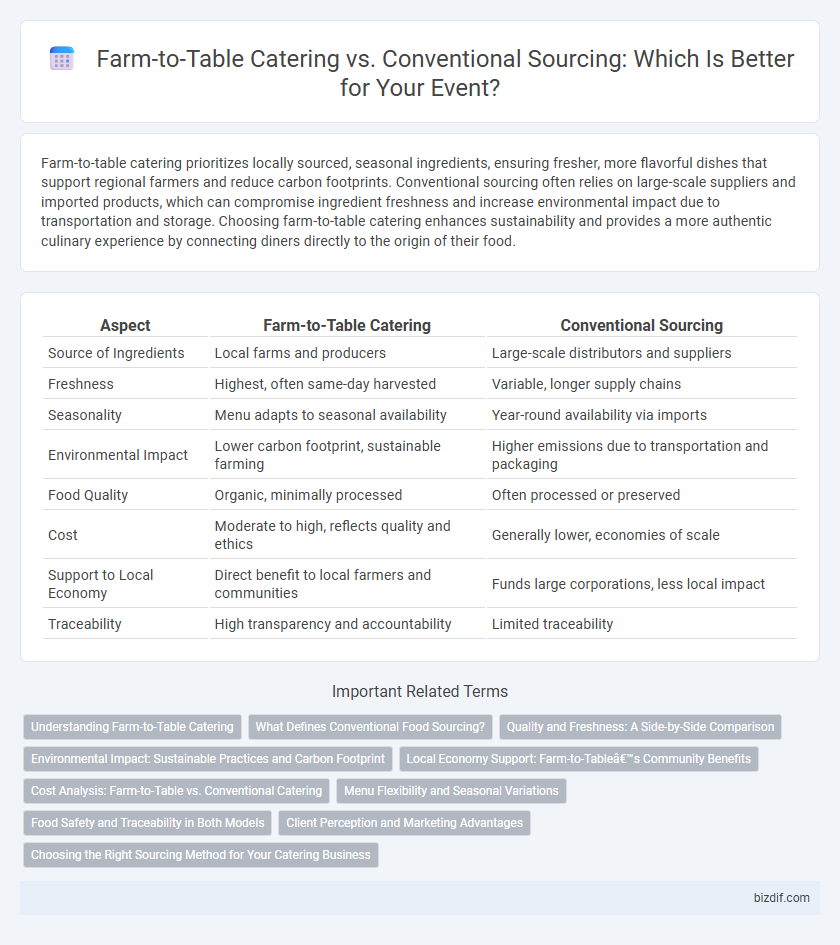Farm-to-table catering prioritizes locally sourced, seasonal ingredients, ensuring fresher, more flavorful dishes that support regional farmers and reduce carbon footprints. Conventional sourcing often relies on large-scale suppliers and imported products, which can compromise ingredient freshness and increase environmental impact due to transportation and storage. Choosing farm-to-table catering enhances sustainability and provides a more authentic culinary experience by connecting diners directly to the origin of their food.
Table of Comparison
| Aspect | Farm-to-Table Catering | Conventional Sourcing |
|---|---|---|
| Source of Ingredients | Local farms and producers | Large-scale distributors and suppliers |
| Freshness | Highest, often same-day harvested | Variable, longer supply chains |
| Seasonality | Menu adapts to seasonal availability | Year-round availability via imports |
| Environmental Impact | Lower carbon footprint, sustainable farming | Higher emissions due to transportation and packaging |
| Food Quality | Organic, minimally processed | Often processed or preserved |
| Cost | Moderate to high, reflects quality and ethics | Generally lower, economies of scale |
| Support to Local Economy | Direct benefit to local farmers and communities | Funds large corporations, less local impact |
| Traceability | High transparency and accountability | Limited traceability |
Understanding Farm-to-Table Catering
Farm-to-table catering emphasizes sourcing ingredients directly from local farms, ensuring fresher, seasonal, and sustainably grown produce. This approach reduces food miles and supports local agriculture, promoting environmental responsibility and community economy. Contrasting with conventional sourcing, which relies on mass-produced and transported goods, farm-to-table catering offers enhanced flavor, nutritional value, and transparency from farm to plate.
What Defines Conventional Food Sourcing?
Conventional food sourcing in catering relies on large-scale commercial farms and centralized distribution networks that prioritize volume, cost-efficiency, and year-round availability of ingredients. This method often involves long supply chains, extensive processing, and the use of synthetic fertilizers and pesticides, which can impact the freshness and nutritional quality of food. Catering services utilizing conventional sourcing typically benefit from lower prices and consistent supply but may face challenges related to sustainability and seasonality.
Quality and Freshness: A Side-by-Side Comparison
Farm-to-table catering ensures exceptional quality by sourcing ingredients directly from local farms, preserving peak freshness and nutrient retention. Conventional sourcing often relies on long supply chains, which can lead to diminished flavor and lower nutritional value due to extended storage and transportation. The direct farm-to-table approach guarantees seasonal produce is delivered promptly, enhancing taste and overall meal satisfaction.
Environmental Impact: Sustainable Practices and Carbon Footprint
Farm-to-table catering significantly reduces carbon footprints by sourcing ingredients locally, minimizing transportation emissions compared to conventional sourcing, which relies on long supply chains. Sustainable practices include seasonal menu planning, organic farming, and avoiding synthetic chemicals, which contribute to soil health and biodiversity preservation. By prioritizing local farmers and reducing packaging waste, farm-to-table catering supports environmental conservation and lowers overall ecological impact.
Local Economy Support: Farm-to-Table’s Community Benefits
Farm-to-table catering strengthens the local economy by sourcing ingredients directly from nearby farms, creating a sustainable revenue stream for local producers. This approach reduces the carbon footprint associated with long-distance transportation and fosters community resilience through economic interdependence. Supporting local farmers through catering services promotes job creation and reinvestment within the community, enhancing overall economic growth.
Cost Analysis: Farm-to-Table vs. Conventional Catering
Farm-to-table catering often incurs higher upfront costs due to premium pricing for locally sourced, seasonal ingredients and smaller-scale suppliers compared to conventional catering's bulk purchasing from large distributors. However, farm-to-table options can offer cost savings through reduced transportation expenses, fresher produce with less waste, and the potential for menu flexibility based on availability, which can offset initial expenses. Conventional catering benefits from economies of scale and stable pricing but may face hidden costs like lower ingredient quality and increased food waste, impacting overall cost efficiency.
Menu Flexibility and Seasonal Variations
Farm-to-table catering offers enhanced menu flexibility by incorporating fresh, locally sourced ingredients that change with seasonal availability, ensuring diverse and innovative dish options. Conventional sourcing relies on standardized, mass-produced ingredients with less seasonal variation, resulting in more static menus. Embracing farm-to-table practices enables caterers to highlight regional flavors and adapt menus dynamically to reflect peak harvests and local produce trends.
Food Safety and Traceability in Both Models
Farm-to-table catering emphasizes enhanced food safety and traceability by sourcing ingredients directly from local farms, enabling precise tracking of produce origins and reducing contamination risks. Conventional sourcing relies on broader supply chains, increasing complexity in traceability and potential exposure to food safety issues due to multiple handling points. Implementing stringent tracking systems in both models is crucial, but farm-to-table catering inherently supports greater transparency and quicker response to safety concerns.
Client Perception and Marketing Advantages
Farm-to-table catering enhances client perception by emphasizing freshness, sustainability, and local ingredient sourcing, which resonates strongly with eco-conscious consumers. This approach allows caterers to market unique, seasonal menus that differentiate their services from conventional sourcing reliant on mass-produced ingredients. Emphasizing traceability and community support in marketing materials builds trust and loyalty, ultimately driving higher client engagement and brand value.
Choosing the Right Sourcing Method for Your Catering Business
Farm-to-table catering emphasizes locally sourced, fresh ingredients that enhance flavor and support sustainable agriculture, often leading to higher customer satisfaction and a unique brand identity. Conventional sourcing offers consistent availability, cost control, and scalability by relying on established supply chains and bulk purchasing. Choosing the right sourcing method depends on your catering business's target market, budget, and priorities for quality, sustainability, and operational efficiency.
farm-to-table catering vs conventional sourcing Infographic

 bizdif.com
bizdif.com